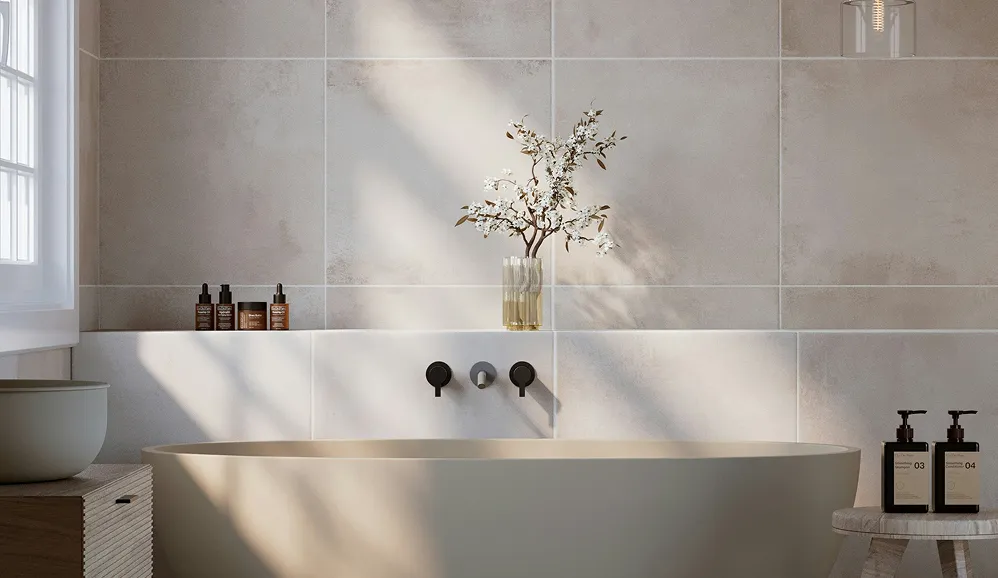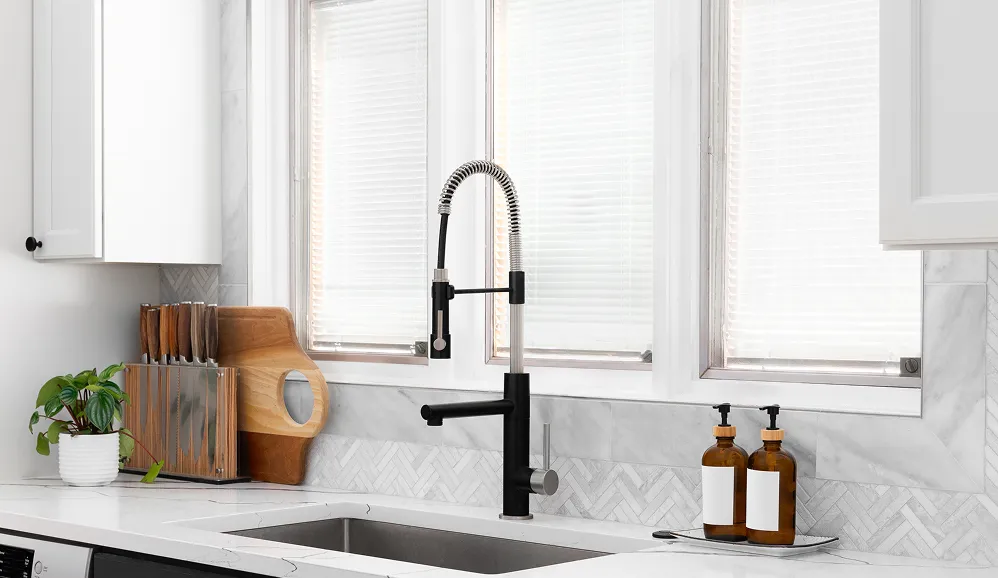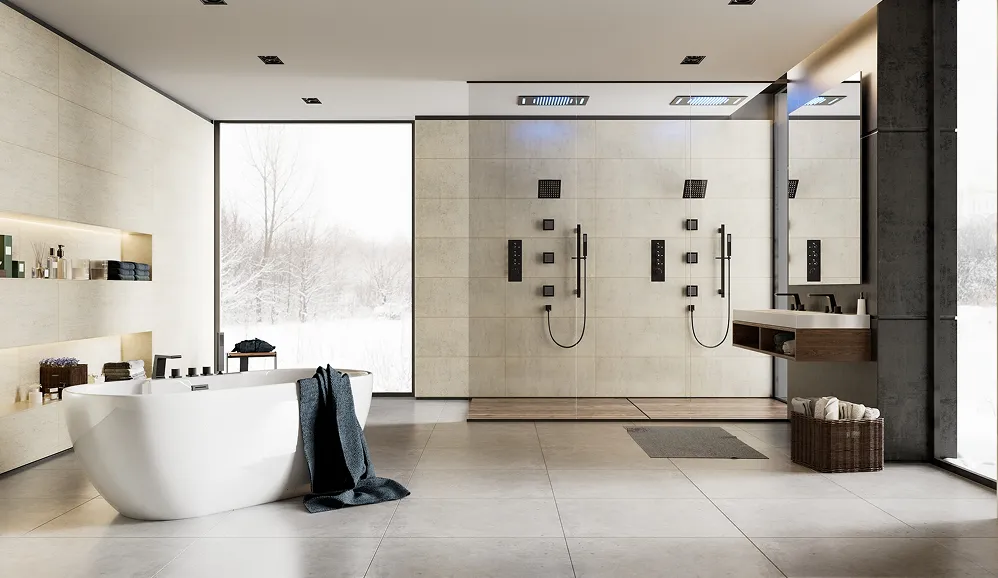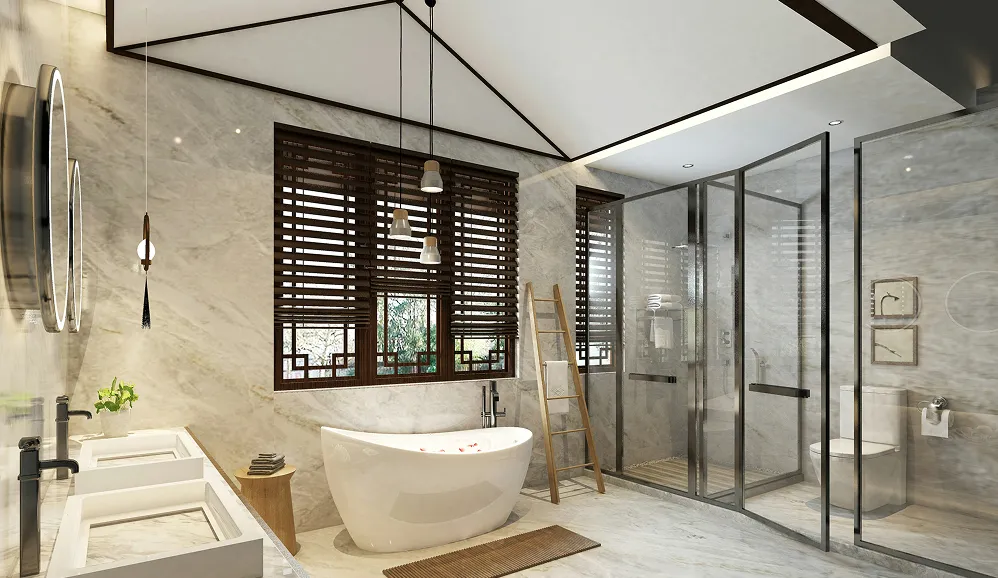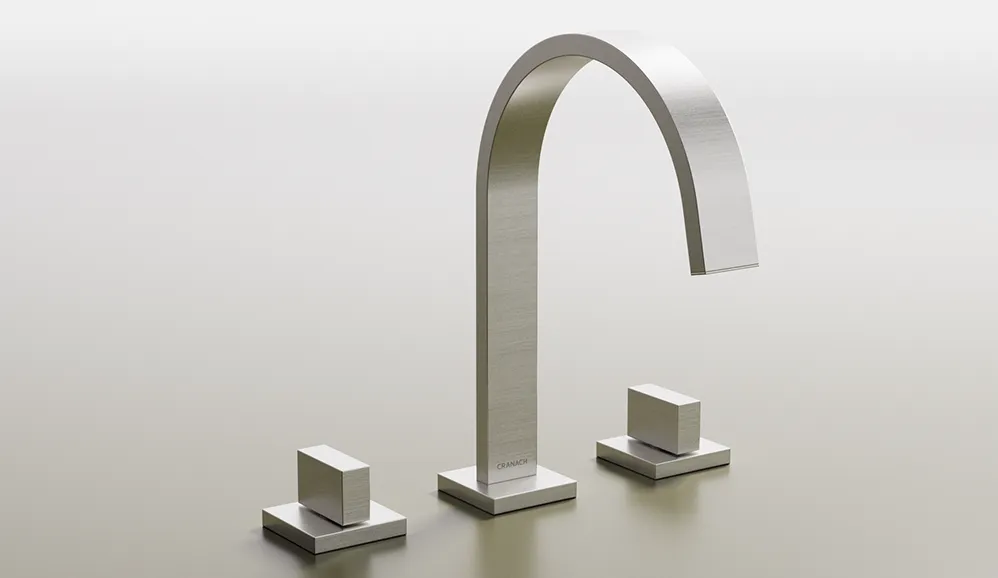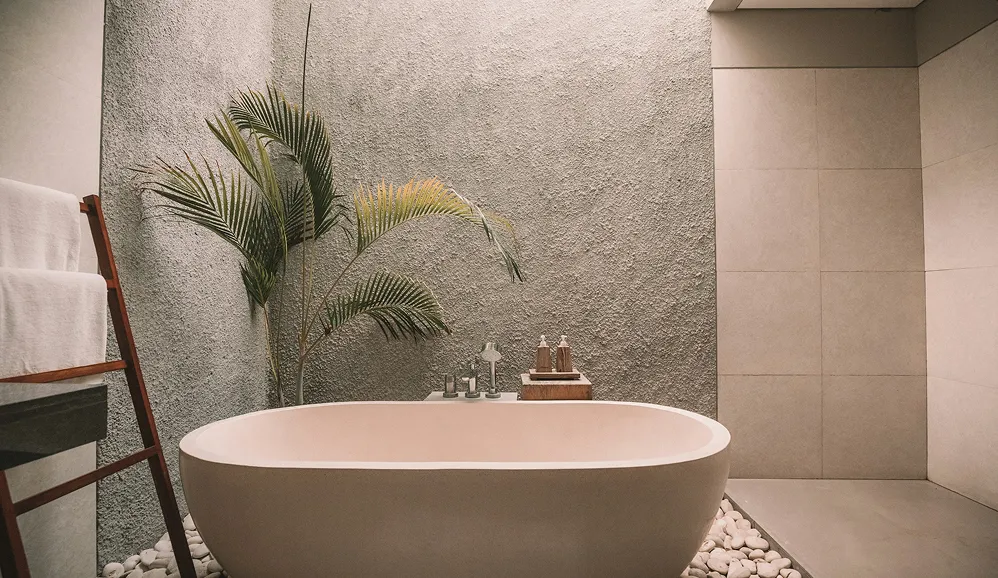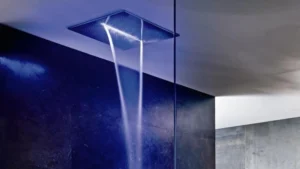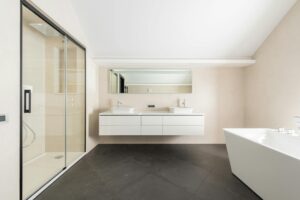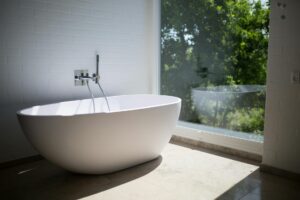When you start asking, “how much does it cost to remodel a shower,” you’ll find the answer isn’t a single number. The final price tag can swing from a few thousand dollars for a simple refresh all the way up to $15,000 or more for a truly luxurious overhaul.
Most homeowners find their projects land somewhere between $3,000 and $7,000, but think of that as just a ballpark figure.
Your Upfront Shower Remodel Cost Guide
The total cost of your shower remodel is a story written by your choices. The materials you fall in love with, how much work is needed to bring your vision to life, and any custom touches you add will all play a starring role in the final bill. Getting a handle on these key factors is the first real step to creating a budget that works for you.
To make things a bit easier, we can break down shower remodels into three general tiers. A basic refresh, for instance, might run you between $1,500 and $4,000. If you’re aiming for something more substantial, like a mid-range walk-in shower with some beautiful custom tile and better fixtures, you’re likely looking at the $5,000 to $10,000 range.
And for those who want the absolute best? A high-end, spa-like retreat with premium materials and sophisticated features can easily start at $12,000 and climb upwards of $25,000. If you want to dive deeper into what drives these costs, this financial analysis from Forbes offers a great breakdown.
This image gives you a solid visual of where your money typically goes in a standard shower project.
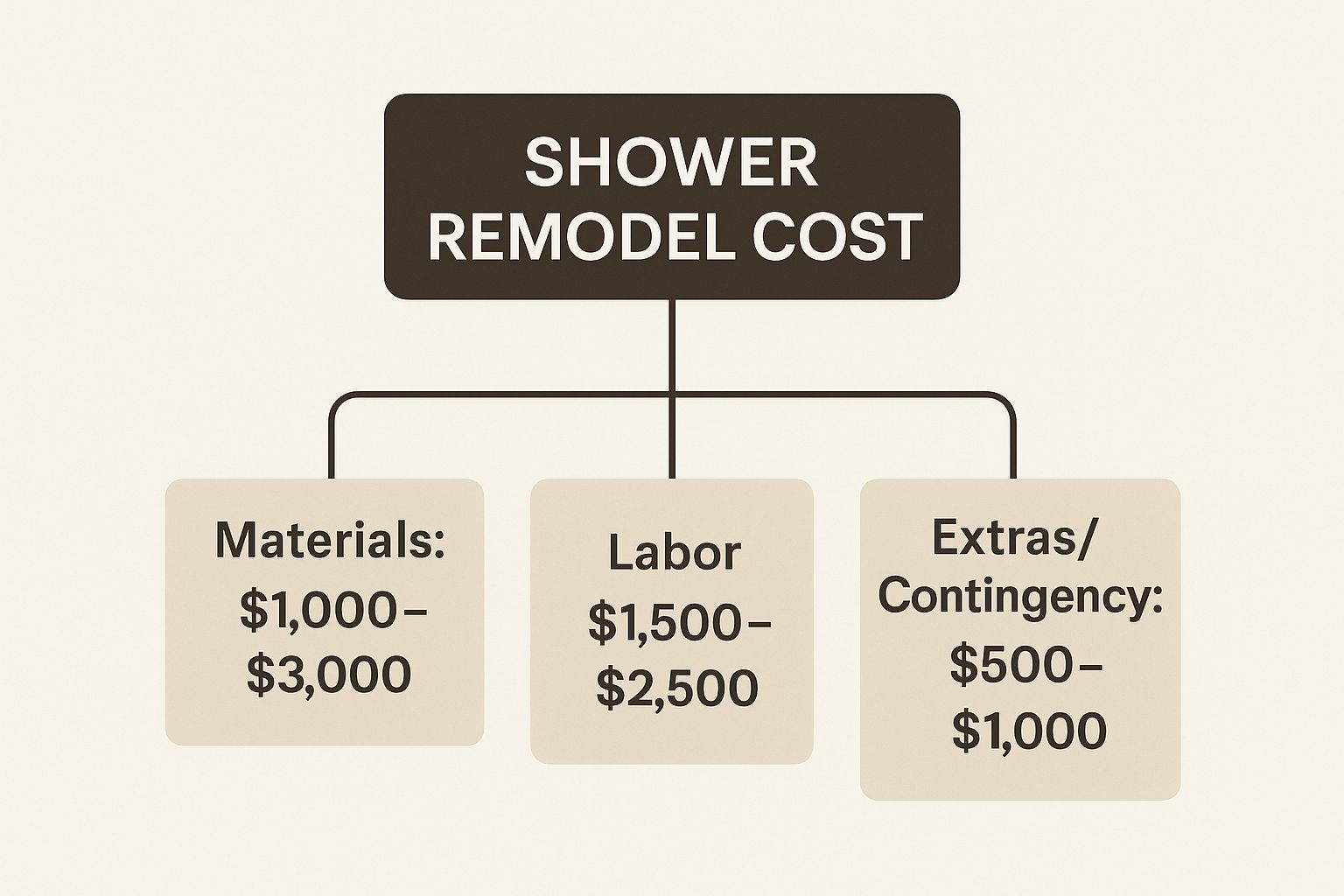
As you can see, the bulk of the budget is split between labor and materials. It’s also smart to set aside a little extra for those “just in case” moments that can pop up in any remodel.
Shower Remodel Cost Tiers at a Glance
To give you a clearer picture, here’s a quick summary of what you can generally expect at each price point. This table breaks down the typical scope of work for basic, mid-range, and high-end projects.
| Remodel Tier | Average Cost Range | Typical Scope of Work |
|---|---|---|
| Basic | $1,500 – $4,000 | Swapping out old fixtures, adding a new shower door, and using standard ceramic or porcelain tile. |
| Mid-Range | $4,000 – $10,000 | Building a new walk-in shower, adding custom tile with built-in niches, and upgrading to a quality shower system. |
| High-End | $10,000+ | Creating a custom design with luxury materials like natural stone, installing frameless glass, and adding advanced plumbing. |
Ultimately, whether you’re just planning a simple update or a complete bathroom transformation, understanding the financial side of things from the start is absolutely essential.
For more ideas and help with planning your numbers, you might find our guide on estimating your shower remodel budget really helpful.
What Drives Your Total Remodel Price
Ever wonder why your neighbor’s shower remodel cost a cool $3,000, while the folks down the street spent over $15,000? That massive price difference isn’t random. The real story behind how much it cost to remodel a shower boils down to just three things: the materials you choose, the cost of labor, and the sheer scope of the project.
Think of these three factors as the main control knobs for your budget. You can turn them up or down. If you fall in love with premium natural stone instead of standard ceramic tile, you’re turning up the material knob. Likewise, opting for a fancy, multi-function shower system is a much bigger investment than a simple, single-head fixture.
Every one of these choices directly impacts that final invoice. Understanding this gives you the power to decide where to splurge and where you can pull back to save a few bucks.
The Major Cost Factors Explained
So, where does all the money actually go? Breaking down your budget shows that the expenses fall into a few key buckets that every homeowner needs to plan for.
- Materials: This is the stuff you see and touch every day. It’s everything from the tile for the walls and floor, the glass for the door, the waterproof backer board underneath it all, and the shower fixtures themselves. A basic acrylic surround is worlds cheaper than a wall of intricate mosaic tile.
- Labor: This is often the biggest line item on the bill, and for good reason. You’re paying for skilled pros to handle demolition, plumbing, tiling, and installation. Getting it right means a beautiful shower that doesn’t leak. The more complicated the design, the more skilled hours it takes.
- Project Scope & Complexity: Are you just swapping out old fixtures for new ones in the same spots? Or are you tearing everything out to build a bigger, custom walk-in shower? Moving plumbing, expanding the footprint, or adding built-in benches and niches will drive up both labor time and material costs.
A project’s scope is the blueprint for its cost. A simple “rip-and-replace” job will always be more affordable than a gut renovation that reconfigures the entire space.
Looking at projects across the country, the national average for a remodel is around $5,400, but that’s just a midpoint. Costs can swing from as low as $450 for a simple refresh to over $20,000 for a high-end overhaul. Labor is a huge piece of that puzzle, typically making up 40% to 60% of the total price tag.
Unseen Costs That Can Bust Your Budget
Beyond the tile and fixtures, there are a few hidden variables that can sneak up on you. The biggest wild card is the condition of what’s already behind your walls.
Discovering old, corroded pipes or hidden water damage during demolition isn’t just a headache; it’s an immediate, necessary expense. Factors like the condition of your existing plumbing or the need to run new pipes can dramatically affect the final bill. For complex fixes, you’ll likely need professional plumbing services to get the job done right.
This is exactly why building a contingency fund of 10-20% into your budget is non-negotiable. It’s not about planning to fail; it’s about having a smart safety net for the common surprises that pop up in almost every remodel. When you have a firm grasp of all these cost drivers, you’re in the best position to make smart choices for your project.
A Detailed Cost Breakdown of Materials
To really wrap your head around how much it costs to remodel a shower, you have to look at the price of each individual piece. Think of it like a grocery list for your renovation—every single item has a price tag that adds to the final bill. The choices you make here, from the walls you’ll see every day to the fixtures you touch, are what will ultimately shape your budget.
Your material costs really start with the biggest surfaces: the shower walls and floor. This is where you’ll find a massive range in pricing.
For the walls, basic acrylic or fiberglass panels are the most wallet-friendly, usually landing somewhere between $300 and $800. If you want to step it up a bit, classic ceramic or porcelain tile is a popular choice, typically running $5 to $15 per square foot, not including the installation materials.
Then you get to the high end. Materials like natural stone or large-format slabs create that seamless, luxurious feel but they definitely come with a premium price. If you’re curious, looking into the costs and benefits of porcelain slabs for bathroom renovations can give you some great insight into how these premium choices impact the bottom line.
Fixtures and Glass Doors
Next up on the shopping list are the fixtures and the shower door. These two elements define both the function and the style of your new shower. A standard, framed shower door might set you back $400 to $900, whereas a sleek, modern frameless glass enclosure can easily sail past $1,500.
Fixtures are another key variable. You can find a simple, functional showerhead and valve for under $200. But let’s be honest, many of us are looking for something more—an integrated solution that turns a regular shower into a real experience.
Choosing your materials is a balancing act. Your goal is to find the intersection where your aesthetic vision meets your financial reality.
A perfect example is a modern shower system. These units bundle multiple components—like an overhead rain shower, a handheld sprayer, and even body jets—into one cohesive, factory-tested package. Investing in a high-quality CRANACH shower system, for instance, can elevate a standard shower into a daily spa-like retreat, combining true luxury with reliable performance.
Essential Behind-the-Scenes Materials
Finally, let’s not forget the less glamorous—but absolutely critical—materials that you don’t even see. These are the foundational elements that make sure your shower stays waterproof and solid for years and years.
- Waterproofing Membrane: This is your number one defense against leaks and water damage. You should expect to spend $100 to $300 for quality waterproofing materials in an average-sized shower.
- Backer Board: This gets installed behind the tile, giving it a stable, moisture-resistant surface to stick to. It typically costs around $15 to $20 per sheet.
- Shower Pan: This is non-negotiable for proper drainage. Whether you go for a pre-fabricated base ($200 – $600) or a custom-built tile pan ($500 – $1,200), you absolutely need one.
By breaking down the costs item by item, you can start to strategically plan your budget. If you want to get even more specific, you can check out our guide on what a walk-in shower costs to build. This kind of detailed knowledge empowers you to decide where to splurge on premium features and where you can choose more budget-friendly options without skimping on quality.
Walk-In Shower vs. Tub Combo: Which Is Right for Your Remodel?
One of the first big questions you’ll face in a shower remodel is a fundamental one: are you picturing a sleek, modern walk-in shower, or are you sticking with a classic, practical tub-shower combination? This decision goes way beyond your daily routine. It directly impacts your total budget, the final look and feel of the room, and even your home’s resale value down the road.
There’s no single “right” answer here. The best choice is deeply personal and depends entirely on your lifestyle, the size of your bathroom, and what you’ve planned financially.
If you’re keeping a close eye on the budget, a standard tub-shower combination is almost always the more wallet-friendly path. The installation tends to be more straightforward, often using a prefabricated tub and surround panels, which helps keep a lid on both material and labor costs.
But for anyone who needs better accessibility or just loves that open, luxurious feel, a walk-in shower is hard to beat—even if it usually comes with a higher price tag.
The Cost of a Walk-In Shower
Think of a walk-in shower as a custom-built project from the ground up. This means you’re looking at more intensive labor and specialized materials to create a space that’s not only beautiful but also completely waterproof. Several key things drive up the cost:
- Extensive Tiling: Custom tile work for the walls and floor isn’t just about sticking tiles on a wall. It requires a skilled installer’s meticulous hand to get it right.
- Complex Waterproofing: This is the part you can’t see but absolutely cannot skip. Building a waterproof base (the shower pan) and ensuring every single seam is sealed is a non-negotiable, labor-intensive process.
- Glass Enclosures: Those gorgeous frameless or semi-frameless glass doors and panels are a significant material expense. It’s not uncommon for the glass alone to cost $1,000 or more.
- Plumbing Modifications: If you’re converting an old tub space, the project often requires moving the drain and other plumbing lines, which adds to your plumber’s bill.
Because of all these custom elements, a walk-in shower project can easily sail past the $10,000 mark. If this is the route you’re leaning toward, our detailed guide can give you more specific numbers on what a new walk-in shower might cost.
The Cost of a Tub-Shower Combo
Opting for a tub-shower combination is often a much more cost-effective approach. While you can certainly go high-end with designer tubs and custom tile surrounds, standard installations offer some serious savings.
Industry data shows that while the average shower remodel hovers around $7,100, the type of installation is a major cost driver. A tub-shower combo can be done for around $3,000, whereas a walk-in shower often surpasses $10,000. Labor alone consistently eats up 40% to 60% of the total project expense.
It’s interesting to note that the actual size of the shower often has less impact on the final price than the complexity of the job and the materials you choose.
Ultimately, the choice comes down to striking a balance between your budget and what you want in terms of function and style. A tub combo is fantastic for families with young kids or anyone who truly enjoys a good soak. A walk-in shower, on the other hand, offers unbeatable accessibility and a clean, modern aesthetic.
The good news? A sophisticated shower system can be installed in either setup, so you can bring that touch of spa-like luxury to your bathroom no matter which configuration you choose.
How to Save Money on Your Shower Remodel
A jaw-dropping shower remodel doesn’t have to empty your wallet. It’s easy to get swept up in the dream of high-end materials and custom everything, but you don’t need a massive budget to get a massive impact. The secret is knowing where to spend and where to save.
Think of it like a financial planner would. You need to make smart, deliberate choices that stretch every dollar. This process starts long before a single tile gets ripped out. Your most powerful tool? Getting detailed, itemized quotes from at least three different reputable contractors. This lets you compare not just the final number, but exactly what’s included for that price.
Smart Budgeting and Strategic Planning
First things first: create a safety net for your budget. Remodels are famous for unearthing surprises once the walls are open—think hidden water damage, old-school plumbing that needs an upgrade, or even mold.
Set aside a contingency fund of at least 10% to 20% of your total budget. This isn’t money you’re planning to spend; it’s your insurance policy against the unexpected issues that could otherwise completely derail your project.
With your budget locked in, it’s time to shop smart. While we all want the most luxurious materials, you can often find stunning, cost-effective alternatives that deliver a nearly identical look. For example, high-quality porcelain tile can beautifully mimic expensive natural stone for a fraction of the price. You can also look into broader budget-friendly renovation tips for more ideas on maximizing value across your entire project.
Know When to DIY and When to Hire a Pro
One of the biggest money-savers is tackling some of the labor yourself—but you have to be strategic about it. Some jobs are perfect for a confident DIYer, while others are best left to the pros to avoid costly, headache-inducing mistakes down the line.
Potential DIY Tasks:
- Demolition: Carefully tearing out old tile, fixtures, and vanities can save you hundreds in labor costs right off the bat.
- Painting: A fresh coat of paint is a simple, high-impact job that requires more patience than specialized skill.
- Minor Installations: You can probably handle installing accessories like towel bars, mirrors, or even a new toilet.
On the other hand, some jobs carry way too much risk for a weekend warrior. Plumbing and electrical work are non-negotiable—always hire licensed professionals. An improperly installed shower system can lead to leaks and devastating water damage. This is also true for making sure your new fixtures have the right pressure; if you run into trouble, a pro can show you how to increase water pressure in your shower.
Likewise, complex tile work and, most importantly, waterproofing require an expert’s touch to guarantee a durable, long-lasting finish. Trust us, paying for a professional’s expertise upfront is always cheaper than paying to fix a major problem later. By balancing smart material choices with a little bit of your own sweat equity, you can keep your shower remodel on track and your budget firmly under control.
Answering Your Top Remodel Questions
As you get closer to kicking off your project, a few final questions are probably popping into your head. It’s completely normal. Nailing down the logistics, understanding the real value, and pinpointing the key cost drivers is what separates a smooth project from a stressful one. Let’s walk through the most common questions homeowners have when they’re figuring out how much it costs to remodel a shower.
How Long Does a Typical Shower Remodel Take?
For a standard shower remodel, you can expect the work to last anywhere from 3 to 7 days. A straightforward job, like swapping out an old prefabricated unit for a new one, might only take a couple of days. It’s a relatively simple in-and-out process.
However, if you’re dreaming of a custom walk-in shower, that’s a different ballgame. These projects are much more involved, with demolition, plumbing rerouting, intricate waterproofing, and meticulous tile work all adding to the clock. A project like that can easily stretch to a week or even longer. It’s always smart to build a little extra time into your schedule for those “just in case” moments, like discovering hidden issues behind the drywall or unexpected material delays.
Is It Cheaper to Retile a Shower or Replace It?
Nine times out of ten, just retiling your existing shower will be the more budget-friendly route. This approach is purely cosmetic, focusing only on what you can see. You end up saving a good chunk of change on the labor that would have gone into demolition and reconstruction.
But there’s a big “if” here. This is only a good idea if the bones of your shower—the backer board, waterproofing membrane, and plumbing—are in rock-solid shape. If there’s even a hint of underlying water damage or rot, a full replacement isn’t just an option; it’s the only responsible long-term fix to head off much bigger problems down the road.
What Is the Most Expensive Part of a Shower Remodel?
Labor and tile. Without a doubt, these two are consistently the biggest line items on any shower remodel invoice. The expertise of skilled plumbers and tile setters isn’t cheap, and their work can easily account for 40-60% of your total project cost.
On the materials side, your tile selection is a huge factor. Gorgeous natural stone or sleek large-format slabs will cost significantly more than classic ceramic or porcelain tiles. Other high-ticket items that can drive up the price include a custom frameless glass enclosure and a premium, multi-function shower system designed for a true spa-like feel.
Does a New Shower Add Value to My Home?
Absolutely. A bathroom remodel, especially a thoughtfully designed shower upgrade, delivers one of the best returns on investment (ROI) you can get. According to a report from the National Association of the Remodeling Industry, a bathroom remodel can recoup over 60% of its cost at resale.
A modern, functional, and stylish shower is a massive selling point for potential buyers. It makes your whole home more marketable, turning it into a smart financial move. As you plan, you might also be interested in understanding how much water a new shower might use—it’s amazing to see how modern, efficient fixtures can lead to long-term savings, too.
Ready to create the shower of your dreams? A CRANACH shower system can transform your daily routine into a therapeutic, spa-like experience. Explore our collection to find the perfect centerpiece for your remodel.
Discover the CRANACH Shower System Collection

